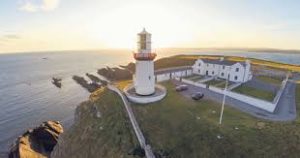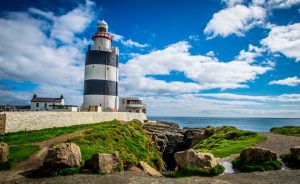KHSK Economic Consultants were commissioned by Irish Lights to review the socioeconomic impact of the Great Lighthouses of Ireland initiative.
Great Lighthouses of Ireland is an all-island initiative has been developed by Irish Lights in collaboration with tourism agencies to promote the re-use of lighthouses and other adjacent buildings as tourism attractions.

There are currently 13 sites, including the Great Light on the Titanic Walkway in Belfast, marketed under the brand of the Great Lighthouses of Ireland. Services to tourists at these sites are provided by private and community operators who hold leases from Irish Lights who continue to own most of the sites.
Main Findings of the Review
The study found that the strategy that has been adopted to develop and implement the Great Lighthouses of Ireland initiative is very well aligned with numerous relevant policy statements.
There is a strong regional element as all the lighthouses are located in rural areas and often in remote places with few opportunities for economic development. Many of these areas are socioeconomically weak having lost much of the most productive parts of their populations to the stronger urban areas.
A notable feature of the initiative is its all-island coverage. Four of the 13 sites are located in Northern Ireland and the initiative, which aims to reposition and reuse heritage assets as tourist attractions, with a strong emphasis on community involvement and impact, is very well aligned with the tourism policy strategies that are being implemented both in the Republic and in Northern Ireland.

While there are similarities, the operations are quite disparate in terms of size and, importantly, in terms of the primary objectives of the operators. This could have implications for the future development of the businesses and the brand.
By far the largest numbers of visitors are attracted to those sites that provide a tour and that have developed a visitor centre with catering. These sites also have the largest employment impact.
However, with the exception of Fanad Head, none of the sites provide a full range of services to tourists encompassing accommodation, food and tours. There will need to be increased investment in infrastructure, business skills and marketing to develop the full tourism potential of the sites.
Estimates of Economic Impact
It is estimated that there were 143,580 ticketed visitors to the 12 lighthouses in 2018. It is known that many more people visited the sites but were not recorded.
Direct expenditure by visitors in 2018 in the lighthouses amounted to €1.92 million. Many of these visitors were attracted to the area because of the lighthouse and also spent money in the local economy. This is valued at €4.92 million in 2018.
There were also other visitors who were attracted to the area by the lighthouse but did actually engage in any transaction there. Their expenditure is assessed at €3.57 million.
This gives total direct expenditure in 2018 associated with the lighthouses that are included in the Initiative of €10.41 million.
This initial expenditure gives rise to subsequent economic activity as incomes are re-spent and as the lighthouse operators buy local goods and services. The value of this activity is assessed at €6.45 in total.
Some of this secondary impact will occur outside the local area but, given that over 65% of the total revenues that are earned in the lighthouses is directly recycled back into the local economy in the form of wages and other purchases, much of it will arise in areas close to the lighthouses.

This activity has a considerable impact on job creation. There are 80 jobs in the lighthouses, but the direct impact of visitors who are attracted to the area of a lighthouse is the creation of 310 local jobs in all tourism businesses in the area.
Furthermore, it is likely that many of the 26 jobs that are created as a result the indirect and induced effects of direct expenditure in the lighthouses will be in the local area. Overall, it is estimated that the GLI initiative supports 409 jobs in the economy.
Non-Monetary Values
The lighthouses have a number of other important positive impacts, but placing monetary estimates on these is much more problematic. These impacts create public benefits, but they are non-market benefits in the sense that there is no transaction involved from which a monetary value can readily be estimated.
These values include conservation value, future use value, and bequest value. Conservation value arises from people simply knowing that the buildings are there and are being looked after. Future use value arises because preserving the lighthouses means that an option is being created that can be exercised in the future. The wish to bequest value is a strong impulse in families but definitely exists in society as a whole also.
One indication of the positive importance of this type of value is obtained from the consultations which showed that local communities take great pride and place great value on ‘their’ lighthouse being open for business and being conserved.
Methodologies have been developed and used in other research studies to assess these categories of values. These have shown that the wish to conserve heritage and pass it on to future generation is highly valued by the public such that public investment for this purpose often has a much greater return than investment for current use.
However, these methodologies are difficult to implement and there are no instances where values have been derived that could be used to identify even indicative metrics for the lighthouses. This does not mean that it is impossible to do so, but the research has not been done.

Failure to include consideration of these values in any public funding decisions risks underestimating the value of heritage preservation. It also means that the socioeconomic value of the Great Lighthouses of Ireland initiative, through helping to preserve the buildings and, in a number of cases, provide access to them, exceeds the values that can be identified from transactions alone.
Future Development
The Great Lighthouses of Ireland initiative is a positive and important intervention and provides support for the socioeconomic development of the areas where the lighthouses are located. There are many benefits associated with investment in such facilities that accrue to the wider community rather than to private operators. The positive impact of public support is clear where assistance as has been provided to date.
The initiative has only been implemented for a few years, with some of the operations still in a start-up phase, and the full potential benefits remain to be realised. However, the differences in the range of services that are provided are excessive and greater co-ordination in this respect is required if the brand is to develop further.
The GLI initiative shows that the lighthouses offer the opportunity to spark economic activity in relatively remote locations that are often weak in socioeconomic terms. However, development and investment plans must fully recognise that it is meaningless to assess the potential of the lighthouses simply in terms of transactions between tourism operators and visitors.
Important economic value that lies in heritage and the potentially high returns to investment in heritage in terms of local and community development. Monetary quantification can seldom capture these values adequately, but they must be included in public expenditure decisions.
The sites are of community heritage importance as much for the stories they represent as for the buildings. The fact that these stories are still present in active living memories is important, but this will not be the case in a short number of years. The next stage of development needs to centre on preserving these stories for communities and for visitors through artefacts and installations.
Marketing to date has centred on the spectacular locations of many of the lighthouses and the unique feature of accommodation in these buildings. This will continue to be the case, but it needs to also develop to integrate the heritage aspects into marketing and to locate the lighthouses within Ireland’s unique culture and heritage.
